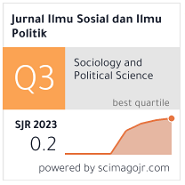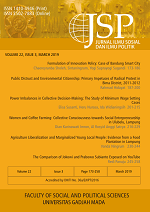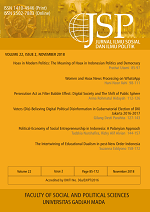Indonesian Migrant Workers in Taiwan: The State Dilemma and People’s Realities
Ali Maksum(1*), Ching-lung Tsay(2), Ali Muhammad(3)
(1) Department of International Relations, Universitas Muhammadiyah Yogyakarta, Indonesia
(2) Department of Diplomacy and International Relations, Tamkang University
(3) Department of International Relations (Masters Program), Universitas Muhammadiyah Yogyakarta, Indonesia
(*) Corresponding Author
Abstract
The role of migrant workers is frequently marginalized amid industrial development, labor shortages, and the domination of state to state arrangements. In fact, the position of migrant workers should be considered as a primary factor in bilateral relations and trade agreements, notably between Indonesia and Taiwan. The reason is that the influx of migrant workers has undoubtedly given many benefits to both Indonesia and Taiwan governments. The Indonesian government considered that in the midst of insufficient job opportunities, migrant workers working in Taiwan indirectly lowered the unemployment rate. In addition, Indonesia acknowledged the high contribution of migrant workers by remittances to national income. At the same time, Taiwan recognized the importance of Indonesian migrant workers in the national economy, as well as strengthening Taiwan’s second-track diplomacy with Indonesia vis-à-vis China. This article argues the dynamics of Indonesian migrant workers in Taiwan, influenced by two factors: (1) the state dilemma and (2) people’s realities, affecting the international relations between Indonesia and Taiwan. Therefore, this paper aims to explore possible answers by discussing the state dilemma and peoples’ realities from the perspective of Indonesian workers in Taiwan. This study represents qualitative research supplemented by data obtained from interviews with Indonesian workers in Taiwan. The authors are also intensively contacted and involved through activities with Indonesian workers and communities.
Keywords
Full Text:
PDFReferences
AN Bakar. (2009). Malaysian New ITC Policy: Regulatory Reform and the New Mode of Governance. Journal of Administrative Science, 6(1), 133-160. Retrieved from https://jas.uitm.edu.my/images/2009_ JUNE/6.pdf
Anderson, C. (2010). Presenting and evaluating qualitative research. American journal of pharmaceutical education, 74(8), 141-141. doi:https://doi.org/10.5688/aj7408141
Ataman, M. (2003). The Impact of Non-State Actors on World Politics: A Challenge to Nation-States. Alternatives: Turkish Journal of International Relations, 2(1), 42-66. Retrieved from https://dergipark.org. tr/en/download/article-file/19401
Atje, R., & Gaduh, A. B. (1999). Indonesia- China Economic Relations: An Indonesian Perspective. Jakarta: CSIS.
Barston, R. (2019). Modern Diplomacy. London: Routledge.
BNP2TKI. (2019). Data Penempatan dan Perlindungan TKI Periode 1 Januari - 31 Maret 2019. Retrieved from Jakarta: http://portal.bnp2tki.go.id/read/14229/ Data-Penempatan-dan-Perlindungan- TKI-P eriode-1-JANUARI-S.D-31- MARET-2019.html
Cathcart, A., & Denney, S. (2013). North Korea’s Cultural Diplomacy in the Early Kim Jong-un Era. North Korean Review, 9(2), 29-42. Retrieved from www.jstor.org/stable/43908918
Chen, Y.-H. (2012). Trends in Low Fertility and Policy Responses in Taiwan. The Japanese Journal of Population 10(1), 78-88. from http://www.ipss.go.jp/webj-ad/webjournal.files/population/2012_Vol.10/Web%20Journal_Vol.10_04.pdf
Cho, Y. Y. (2012). Public Diplomacy and South Korea’s Strategies. The Korean Journal of International Studies, 10(2), 275-296. Retrieved from http://www.kaisnet.or.kr/ resource/down/10_2_05.pdf
Chou, B. (2019). Asus, with Dominant Market Share in Indonesia, Now Moves on to Capture Mindshare. Meet Startup@TW 13 August 2019. Retrieved from https://meet.bnext.com.tw/intl/articles/view/45267
Chou, J., & Kuo, C.-h. (2016). Indonesian workers treated well in Taiwan: official. Focus Taiwan 14 January 2016. Retrieved from ht t p:/ / focust aiw an.t w/ news/ asoc/201601140004.aspx
Cull, N. (2010). Public diplomacy: Seven lessons for its future from its past. Place Branding and Public Diplomacy, 6, 11-17. doi:10.1057/ pb.2010.4
Etikan, I., Musa, S. A., & Alkassim, R. S. (2016). Comparison of Convenience Sampling and Purposive Sampling. American Journal of Theoretical and Applied Statistics, 5(1), 1-4. doi:10.11648/j.ajtas.20160501.11
Faustina, A. (2015). Corrdinating Migrant Labor Policy between Taipei and Jakarta: The case of runaway Indonesian workers. (M.A. Thesis), National Chengchi University, Taipei.
Gilboa, E. (2006). Public Diplomacy: The Missing Component in Israel’s Foreign Polic y. Israel Aff airs, 12(4), 715-747. doi:10.1080/13533310600890067
Indonesian Law No. 25. (2007). Undang-Undang No. 25/2007 on Investment.
Kabinawa, L. N. R. W. (2013). Economic and Socio-Cultural Relations between Indonesia and Taiwan: An Indonesian Perspective, 1990-2012. Journal of ASEAN Studies, 1(2), 140-163.
KDEI Taipei. (2014). Sejarah KDEI Taipei Retrieved from http://www.kdei-taipei. org/index.php/2014-08-11-03-58-09/sejarah-singkat. http://www.kdei-taipei.org/index.php/2014-08-11-03-58-09/sejarah-singkat
Keliat, M. (2003). ASEAN dan Dialog ‘People- to-People. CIVIC, 1(2), 1-10. Retrieved from http://staff.ui.ac.id/system/files/ users/make09/material/1-makmur.pdf
Koike, M. (2015). Indonesian Migrant Workers and their “Ethnic Communities” in Taiwan. St. Andrew’s University Sociological Review 49(1), 27-48. Retrieved from https://ci.nii.ac.jp/naid/110009957896/
Lin, W.-I., & Yang, S.-Y. (2009). From Successful Family Planning to the Lowest of Low Fertility Levels: Taiwan’s Dilemma. Asian Social Work and Policy Review 3, 95-112. Retrieved from https://onlinelibrary. wiley.c o m /d o i/pd f/10.1111/j . 1753- 1411.2009.00027.x
Lin, Y.-W., Yen, C.-Y., Yen, C.-L., Hou, Hsin- Yen, , & Chu, Y.-C. (2007). The Causes and Effects of the Declining Birth Rate in Taiwan. Retrieved from Tainan City: http://ir.lib. ksu.edu.tw/bitstream/987654321/704/1/% E5%B0%88%E9%A1%8C%E8%A3%BD% E4%BD%9C.pdf
Loveband, A. (2003). Positioning the Product: Indonesian Migrant Women Workers in Contemporary Taiwan. Retrieved from Hong Kong:
Mashitah, S. D. (2017). A bilateral relation between Indonesia and Taiwan: A case study of higher educaational cooperation between Aceh and Taiwan (2010-2015). (M.A. Thesis), National Chengchi University, Taipei.
Medzini, M. (2012). Reflections on Israel’s Public Diplomacy. Bulletin du Centre de recherche français à Jérusalem [En ligne],2 3. Retrieved from http://journals.openedition.org/bcrfj/6829
Melchert, P. (2017). Indonesian Migrants in Taiwan: Religion and Life-styles. Retrieved from Münster:
Mo, J., & Hahn, K. S. (2005). Public Diplomacy and North Korea Policy: Diverging Effects of U.S. Messages in the United States and South Korea. Journal of East Asian Studies,5(2), 191-214. Retrieved from www.jstor. org/stable/23418288
Mohajan, H. K. (2018). Qualitative Research Methodology in Social Sciences and Related Subjects. Journal of Economic Development, Environment and People, 7(1), 23-48. Retrieved from https://mpra.ub.uni-muenchen. de/85654/1/MPRA_paper_85654.pdf
Mursitama, T. N. (2012). Second Track Diplomacy in ASEAN+3: The Case of Indonesia and Network of East Asian Think-Tanks (NEAT). International Affairs and Global Strategy, 5, 5-10. Retrieved from https://ssrn.com/abstract=2184311
Norrakiah A. S., & Dahlan, H. A. (2015). Current Trend for Food Safety and Halal Measures. Paper presented at the ASEAN Community Conference 11-12 November, Bangi, Malaysia.
Payne, J. Gregory,. (2009). Reflections on Public Diplomacy: People-to-People Communication. American Behavioral Scientist, 53(4), 579-606. doi:https://doi. org/10.1177%2F0002764209347632
Prihatin, S. D. (2007). Potret Buram Perlindungan Tenaga Kerja Indonesia. Jurnal Ilmu Sosial dan Ilmu Politik, 10(3), 325-342. doi:https:// doi.org/10.22146/jsp.11010
Rawnsley, G. D. (2014). Taiwan’s Soft Power and Public Diplomacy. Journal of Current Chinese Affairs, 43(3), 161–174. Retrieved from https://journals.sagepub.com/doi/ pdf/10.1177/186810261404300307
Rickards, & Jane. (2017). Taiwan Looks Southward. Taiwan Business Topics . Retrieved from https://topics.amcham. com.tw/2017/05/taiwan-looks-southward/
Ruenwai, N. (2006). Science and technology information in Thailand: policies, strategies and provision. (PhD Thesis), Loughborough University, Loughborough, UK.
Saner, R., & Yiu, L. (2001). International Economic Diplomacy: Mutation in the post-modern times. Den Haag: Netherland Institute of International Relations “Clingendael”.
Schiff, A. (2010). “Quasi Track-One” Diplomacy: A n Analysis of the Geneva Process in the Israeli–Palestinian Conflict 1. International Studies Perspectives, 11(2), 93-111. doi:10.1111/j.1528-3585.2010.00396.x Setyaningsih, R. P. (2011). Job satisfaction of Indonesian workers in Taiwan. (M.A. Thesis), National Chengchi University, Taipei.
Setyaningsih, R. P. (2011). Job satisfaction of Indonesian workers in Taiwan. (M.A.Thesis), National Chengchi University, Taipei.
Sukma, R. (1994). Recent Developments in Sino-Indonesian Relations. Contemporary Southeast Asia, 16(1), 35-45. Retrieved from https://www.jstor.org/stable/25798231
Sukma, R. (1995). The Evolution of Indonesia’s Foreign Policy: An Indonesian View. Asian Survey, 35(3), 304-315. Retrieved from https://www.jstor.org/stable/2645547
Sundaryani, F. S., & Wirayani, P. (2016). Taiwan promises increased investment in Indonesia. The Jakarta Post, December 1 . Retriev ed fro m https ://www. thejakartapost.com/news/2016/12/01/ taiwan-promises-increased-investment- in-indonesia.html
Tam, L. (2019). Interpersonal approaches to relationship building: Diplomat as a human agent of public diplomacy. Place Branding and Public Diplomacy, 15(2), 134-142. Retrieved from https://eprints.qut.edu.au/119171/
TETO Jakarta.(2017). Taiwan-Indonesia Relations Retrieved from http://www. roc-taiwan.org/id_en/post/1199.html http://www.roc-taiw an.org/id_en/ post/1199.html
Tsay, C.-l. (2015). Migration between Southeast Asia and Taiwan: Trends, Characteristics and Implications. Journal of ASEAN Studies, 3 (2), 68-92. doi:https://doi. org/10.21512/jas.v3i2.842
Waltz, K. N. (1979). Theory of International Politics. Reading, Mass.: Addison-Wesley. Yuniarto, R. (2014). Making Connection”: Indonesian Migrant Entrepreneurial Strategies in Taiwan”. Journal of Identity and Migration Studies 8(1), 95-119. Retrieved from http://e-migration.ro/ jims/Vol8_No1_2014/Articles/JIMS_Vol8_ No1_2014_pp_95_119_YUNIARTO.pdf
Yuniarto, R. (2014). Making Connection”:Indonesian Migrant Entrepreneurial Strategies in Taiwan”. Journal of Identity and Migration Studies 8(1), 95-119. Retrieved from http://e-migration.ro/jims/Vol8_No1_2014/Articles/JIMS_Vol8_No1_2014_pp_95_119_YUNIARTO.pdf
Yuniarto, R. (2015). Social Activist, Patron, and Broker: Indonesian Migrant Entrepreneurs in Taiwan. Ritsumeikan Journal of Asia Pacific Studies, 34, 106-120.
Zhou, T. (2014). China and the Thirtieth of September Movement. Indonesia, 98(29-58). Retrieved from https://www.jstor.org/stable/10.5728/indonesia.98.0029
Article Metrics
Refbacks
- There are currently no refbacks.
Copyright (c) 2021 Jurnal Ilmu Sosial dan Ilmu Politik

This work is licensed under a Creative Commons Attribution-NonCommercial-NoDerivatives 4.0 International License.






















